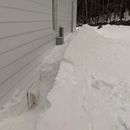Exterior duct material? ERV port is covered in snow
I am finally moving into my pretty good house in NH. I installed our ERV system during the summer of last year. Being new to metal roofs, I underestimated how much snow would pile up.
Needless to say, our ERV exhaust/supply port (panasonic) becomes buried after each storm.
I am thinking of removing the existing dual-function exhaust/supply port and using two separate ducts that will be oriented upward and outward like two opposing snorkels.
Will galvenized duct work for this? The base will almost certainly be covered in snow all winter… Are there better materials for outdoor use? I want to avoid PVC.
Any other ideas?
Thank you
GBA Detail Library
A collection of one thousand construction details organized by climate and house part










Replies
Galvanized would work, but will eventually rust and leak. Use at least 26 gage. You could build a small snorkel shed to protect it from the inevitable snow drops.
ABS pipe is available in 4", which may work depending on your flow rates and the rest of your duct system.
If you only have a little bit of a run, thin-wall stainless steel pipe is an option, as is aluminum. You can get schedule 15 and schedule 20 sizes through commercial supply houses. Normally the fittings would be welded, but you could “glue” them with epoxy or even silicone for something like this since you don’t really have pressure to worry about. You could also have some stainless steel sheet made into duct, but I think the pipe would be cheaper overall since it’s a stock item (no fabrication labor outside what you do yourself).
It might be simpler to just build a little awning and/or a snow fence depending on how much of that snow comes off your roof and how much is a blown drift.
Bill
Matt, Bill;
Thanks so much for the advice!
Rick,
There is also the UBBINK concentric ducting. It has a metal pipe on the inside which you can use as your air inlet. Don't know how easily that can hook up to your existing dual outlet pipe.
After the first winter with metal roofing, I put on snow retention. A roof of snow suddenly falling when it gets warmer sounds like a major car crash outside the house.
Akos- thanks. Looks like an interesting solution. So far, I've only seen UK products but I will dig a little deeper. Thanks again!
Rick,
I've used that pipe for hooking up a Rannai tankless unit, best bet to start your search there. The one for non-condensing unit has the metal inner pipe.
Rick, other than the issue at hand, how do you like the Panasonic? Did you use the Intelli-Balance or the Whisper-Comfort?
Hi Lance,
I have the Cold Climate Intelli-balance. We've only had it running for a few weeks now. So far, I like it. We didn't have it running when it was really cold (I had the ducts sealed up for painting) but I did use it recently when it was about 14 degrees F outside. The supply air was a bit cool but certainly not cold. It was much, much warmer than the air that comes from our heat pump water heater.
The only issue I had was thinking through and ultimately installing the ducts. This turned out to be quite the undertaking. The Zehnder ducts (comfo-tubes) solve a lot of problems and appear to be a breeze to install. You can also rest assured that you will have a well-designed system as Zehnder will map out the supply and exhaust locations as part of the package.
The Zehnder is a better (more efficient) unit at really low temperatures. Their ducts are amazing- especially their insulated ducts for bringing in outside air. The Zehnder systems is certainly easier to install. Panasonic has an insulated duct too but it can only handle 50 cfms!
Nevertheless, you can't beat the Panasonic price. We purchased our intelli-balanace for $800 and we only paid about $400 for the ducts, mastic, tape, tools, etc. The Zehnder we priced out was more than $6,000 for everything.
If the Zehnder is going to cost you $8,000 or so with installation, then I would look into the CERV. I've got to play with a couple up close recently and LOVE them. My only complaint is that they do little to recover humidity in the winter.
Hope this helps :-)
Great to hear, Rick!
There's no doubt the Zehnder is a Cadillac system with a nice looking duct network, but oh boy do you pay for it! The efficiency and price of the Panasonic make it extremely desirable and hard to beat, in my opinion.